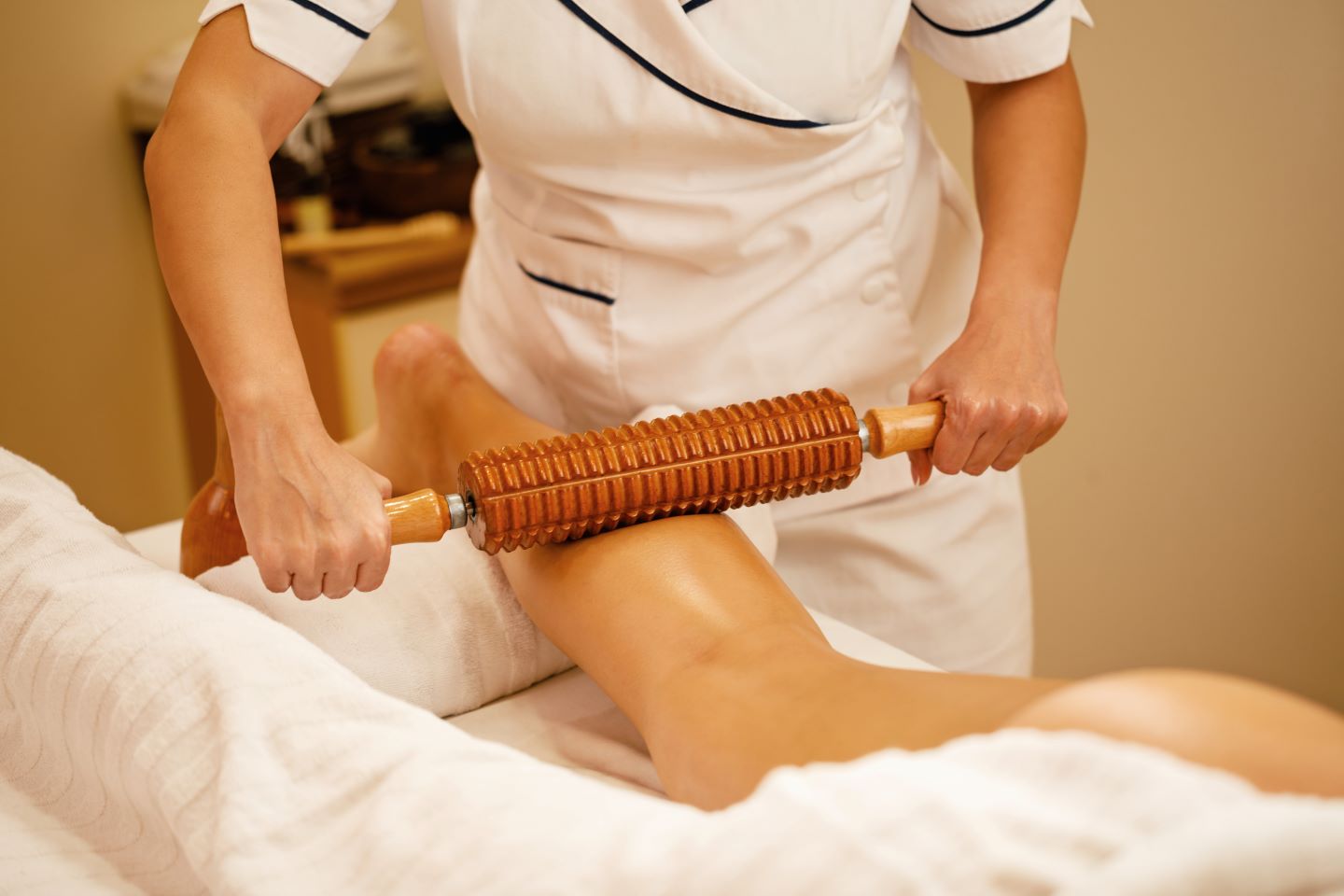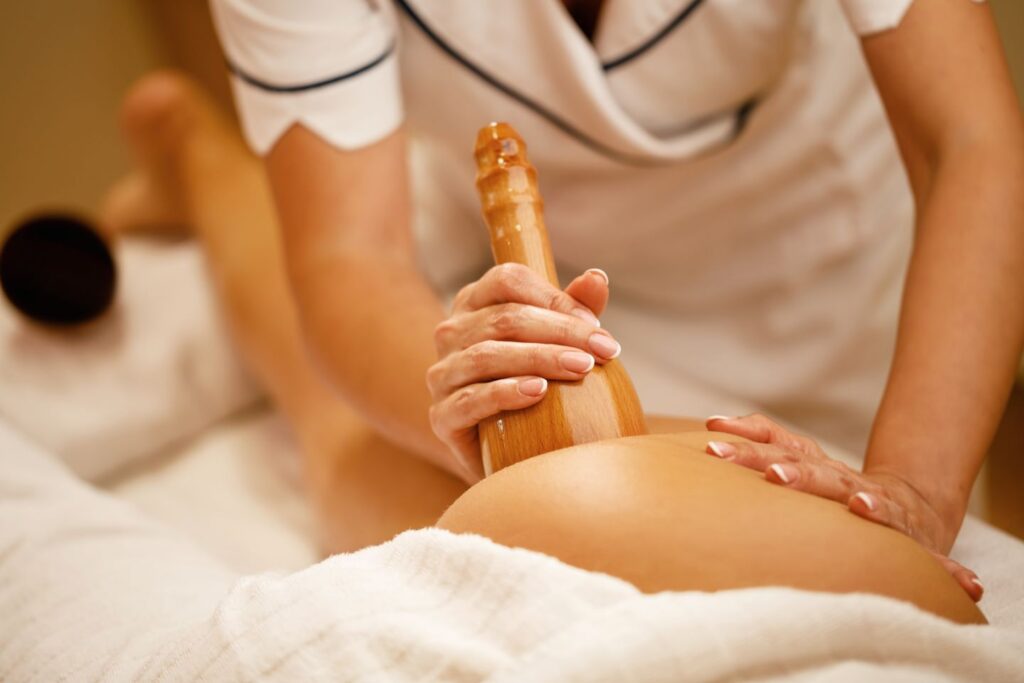Wood Therapy: Potential Benefits, Wood Therapy, Before and After

Wood therapy, a holistic approach to body wellness, has become an alternative massage technique in recent years. This practice uses various wooden tools to manipulate the body’s soft tissues, offering potential benefits such as improved circulation, cellulite reduction, body contouring, relaxation, and enhanced skin tone. While its roots trace back to ancient healing practices, wood-therapy has evolved into a modern therapeutic method with a growing number of practitioners and enthusiasts.
What is Wood Therapy?
Wood therapy, also known as maderotherapy, is a massage technique that uses wooden tools to manipulate the body’s soft tissues. The therapy involves using various specially designed wooden implements, such as rollers, spatulas, and other devices, to pressure and massage the skin and underlying tissues. These tools are typically made from different types of wood and are crafted to suit different body parts and specific massage techniques.
Potential Wood Therapy Benefits
- Improved Circulation: One of the primary purported benefits of wood therapy is the stimulation of blood circulation. The pressure applied by wooden tools is thought to encourage blood flow, potentially aiding nutrient and oxygen delivery to tissues.
- Cellulite Reduction: Wood therapy is often marketed as a solution for reducing cellulite. Practitioners claim that the mechanical action of the tools can break down fat deposits and promote the elimination of toxins, leading to a smoother appearance of the skin.
- Body Contouring: Advocates of wood-therapy suggest that the targeted use of wooden tools can help reshape and contour the body. This is believed to be achieved by promoting muscle toning and addressing specific areas of concern.
- Relaxation and Stress Reduction: Like many other massage techniques, wood-therapy induces relaxation and can reduce stress. The combination of physical manipulation and the soothing properties of wood creates a therapeutic experience for many individuals.
- Enhanced Skin Tone: Wooden tools improve skin elasticity and tone. The massaging action is thought to stimulate collagen production and promote a healthier appearance of the skin.
Historical Roots and Evolution
The use of wood in healing practices has ancient roots, with cultures around the world incorporating wooden tools for massage and body treatments. In traditional Chinese medicine, wooden implements were employed to stimulate acupressure points and balance the body’s energy flow. Similarly, ancient Egyptians are believed to have used wooden tools for massage and skin care, recognizing the benefits of manipulating the body’s soft tissues.
Over time, these practices evolved and merged with other therapeutic techniques. In the modern context, wood therapy has become a specialized form of massage, drawing on traditional knowledge and a contemporary understanding of anatomy and physiology.
Wood Therapy Tools
Wood therapy utilizes various specially crafted wooden tools designed for specific purposes. These tools can include wooden rollers, spatulas, and sculpting instruments, all made from different types of wood. The selection of wood is crucial, with some practitioners using materials like rosewood, beechwood, or other hardwoods known for their durability and smooth texture.
The tools are crafted to accommodate different body parts and various massage techniques. For example, more extensive tools may be used for broad strokes and overall body massage, while more minor, more intricate tools are employed for detailed work on specific areas.

Scientific Evidence and Criticisms
While many proponents of wood therapy attest to its benefits, scientific evidence supporting some of these claims is limited. Research on the specific effects of wooden tools on cellulite reduction or body contouring is sparse, and more studies are needed to establish the efficacy of this technique.
Critics argue that some of the perceived benefits may be attributed to the general effects of massage rather than the use of wooden tools specifically. The pressure, friction, and kneading associated with massage can improve circulation, muscle relaxation, and stress reduction, irrespective of the material used for the tools.
Individual Experiences and Considerations
As with any alternative therapy, individual experiences with wood therapy can vary. Some individuals may find it relaxing and enjoyable treatment, while others may not experience the purported benefits. Factors such as the skill and technique of the practitioner, individual health conditions, and expectations can influence the outcomes of wood-therapy sessions.
Before considering wood-therapy or any other form of massage, individuals with underlying health conditions should consult with healthcare professionals to ensure that the treatment is safe for them. Additionally, it is essential to seek the services of trained and qualified practitioners to ensure the proper application of wood therapy techniques.
The Importance of Practitioner Training
The success and safety of wood therapy sessions depend significantly on the practitioner’s expertise. Proper training is crucial to ensure the wooden tools are used effectively and safely. Many practitioners undergo specialized training programs to learn the techniques, contraindications, and ethical considerations associated with wood-therapy.
Practitioners may also need a comprehensive understanding of human anatomy and physiology to tailor wood therapy sessions to the individual needs of their clients. This includes recognizing the appropriate pressure to apply, understanding the different types of wooden tools and their purposes, and being aware of potential contraindications for specific health conditions.
Wood Therapy Before and After
Wood therapy’s “before” and “after” encompass a spectrum of experiences and potential outcomes. While immediate effects may be visible regarding relaxation and skin appearance, the value of wood-therapy often lies in its contributions to overall well-being and the cumulative, long-term benefits that may unfold with consistent sessions.
Before Wood Therapy
Before embarking on a wood-therapy journey, individuals often present themselves with various concerns about their body’s appearance, skin tone, or perceived cellulite areas. These concerns range from seeking improved muscle definition and contouring to addressing specific aesthetic issues. Before the session begins, individuals may express hopes for a positive transformation in how they feel and perceive their bodies.
In the “before” state, skin texture, muscle tension, and overall body composition contribute to the individual’s self-perception. It’s every day for people seeking wood therapy to have specific goals, whether related to cellulite reduction, body contouring, or simply the desire for a relaxing and rejuvenating experience.
After Wood Therapy
After completing a wood therapy session, individuals often report immediate sensations and potential changes. The most immediate effects are often related to relaxation and reduced muscle tension. Clients may experience a sense of lightness and improved blood circulation, contributing to overall well-being.
Regarding aesthetic changes, some individuals may notice temporary skin tone and texture improvements. The mechanical action of the wooden tools, combined with the massage techniques, can lead to a smoother appearance. Immediate post-treatment photographs may show subtle differences, such as reduced water retention or improved muscle definition.
Important Note: It’s essential to recognize that the long-term outcomes of wood-therapy are often cumulative and may require multiple sessions for more sustained effects. While some changes may be immediately visible, the actual benefits of wood therapy, such as enhanced circulation and potential muscle toning, may manifest over time with consistent sessions.

Conclusion
Rooted in ancient healing practices, Wood therapy massage has evolved into a modern massage technique that utilizes specially crafted wooden tools to manipulate the body’s soft tissues. While the claimed benefits include improved circulation, cellulite reduction, body contouring, relaxation, and enhanced skincare and skin tone, the scientific evidence supporting these claims is limited.
Individual experiences with wood-therapy can vary, and its success may depend on factors such as the practitioner’s skill, particular health conditions, and client expectations. It is essential for individuals considering wood therapy to consult with healthcare professionals and seek the services of trained practitioners to ensure safety and efficacy.






